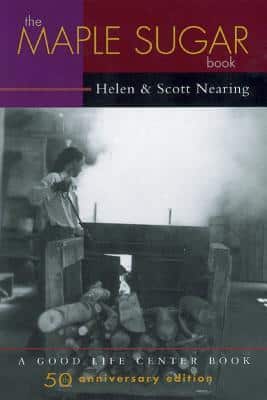“The Maple Sugar Book” by Helen and Scott Nearing is an extensively researched, interesting, and surprisingly funny history of maple sugar making.
In true grass-is-always-greener fashion, summer is sometimes a time for dreaming about when it isn’t so hot out. (Guilty.) In addition to keeping the garden weed-free, moving the chickens to their late-summer quarters (away from the garden) and slowly ticking off the rest of the homestead to-dos, we’ve also started reading up in preparation for our next sugaring season.
“The Maple Sugar Book” by Helen and Scott Nearing, with its treatment of the history and practice of maple sugaring, is our pick for this summer’s maple beach read. It’s extensively researched, interesting, surprisingly funny, and, in and of itself, a fascinating slice of history.
Like so many to follow in the intervening decades, the Nearings left the urban life for an old Vermont homestead and, (like so many to follow in the intervening decades!) with the benefit of an inheritance, connections and some off-the-land income, struck out to make a living on the farm. For them, the journey back to the land started in 1932, at the apex of the Great Depression, spanned the tumult of the last-half of the twentieth century, and continues by way of “The Good Life Center,” a nonprofit Helen created on the coast of Maine before her death in 1995.
The book is separated into three sections; the longest and of most practical use to the hobby sugar maker being the second, a 135-page chronicle of exactly how the Nearings and their peers made maple products around 1950. With chapters for identifying and cultivating prime sugar bushes, choosing the proper equipment, understanding how, why and when sap runs, tapping, storing and processing sap, and making syrup and sugar, this section – despite some obvious anachronisms (a certain tolerance for monoculture and wooden buckets, for example) – is full of practical information and is excellent company for today’s backyard maple syrup maker.
While a reader should feel free to skim or skip chapter 9, regarding marketing maple products in the 1950s (What? No Instagram farms?) and the book’s third section, an extended opinion piece about maple’s place in making country life superior to city life (tending to be preachy, out-of-date and narrow), one should not miss the authoritative history of maple syrup that is contained in section one. Along with detail about how native North Americans obtained and processed sap and stored and served maple sugar, the Nearings throw in precious historical tidbits about how American mothers pacified restless children by feeding them maple sweets (they did it too!) how European settlers experienced maple (it was almost universally love-at-first-taste), took to its cultivation (quickly) and sometimes claimed to have discovered it first (a claim the Nearings skillfully debunk). Finally, don’t forget to take a look at the maple recipes contained at the end of the book, including for maple sugar french toast, maple fudge and a method for making maple icing.
While the book was not popular at the outset, it is now. The 50th Anniversary addition of this gem is widely available and a must-not-miss for any hobby sugar maker with an appetite for learning. So pull up a beach chair or picnic blanket, grab a cold beverage, dig your heels into the sand or grass, and grab a copy from your local library, bookstore, or internet. Happy reading!

